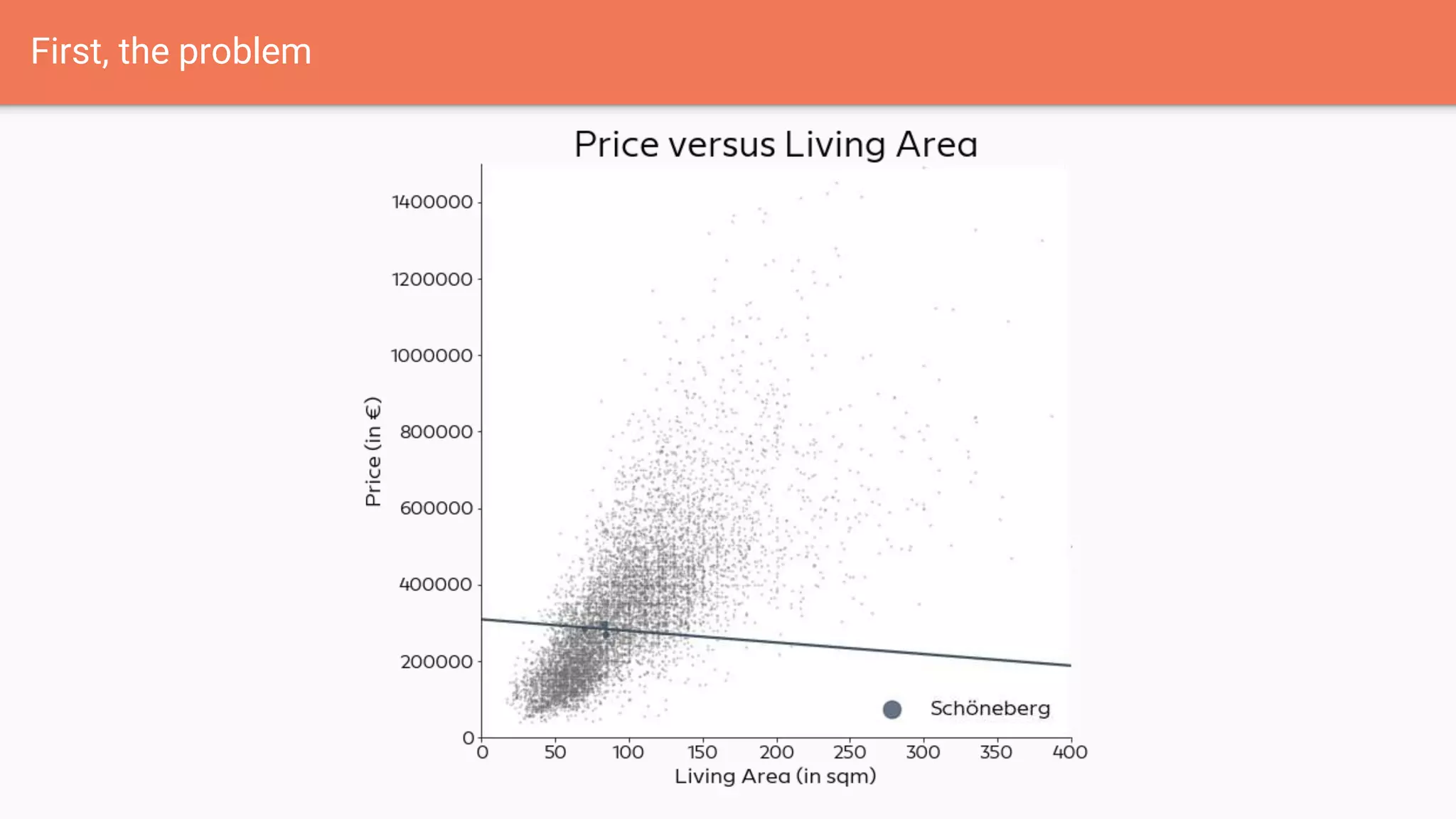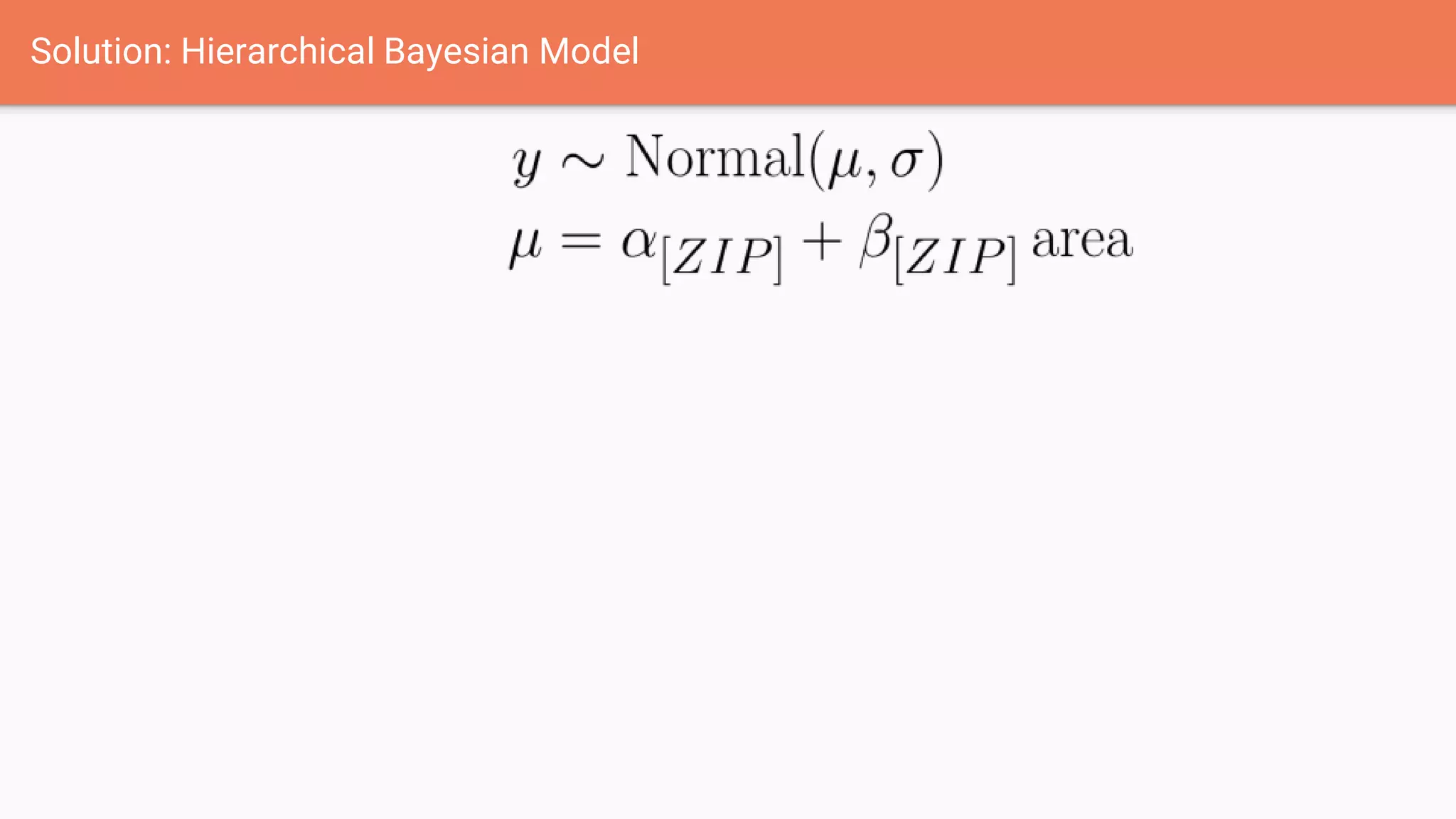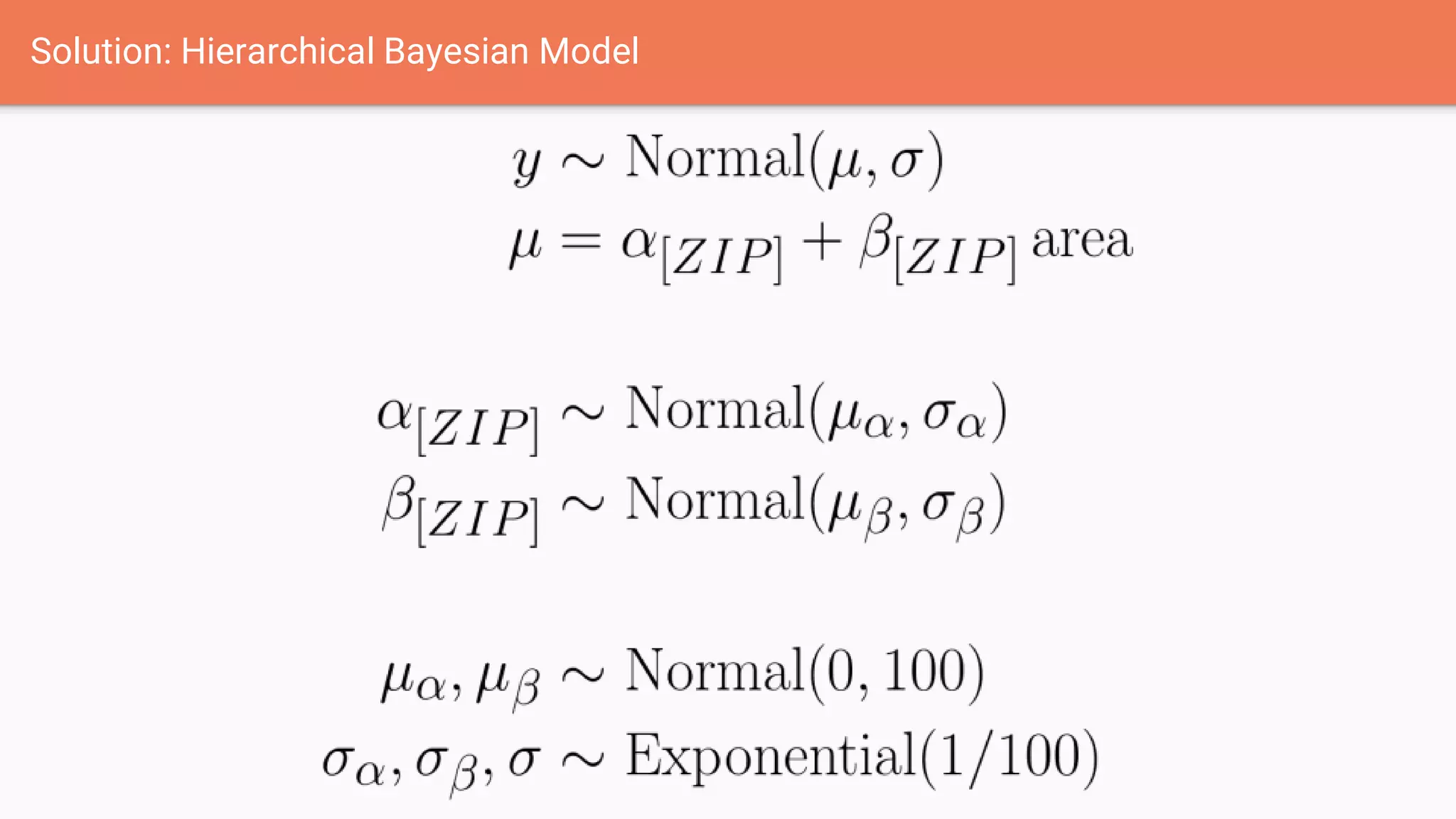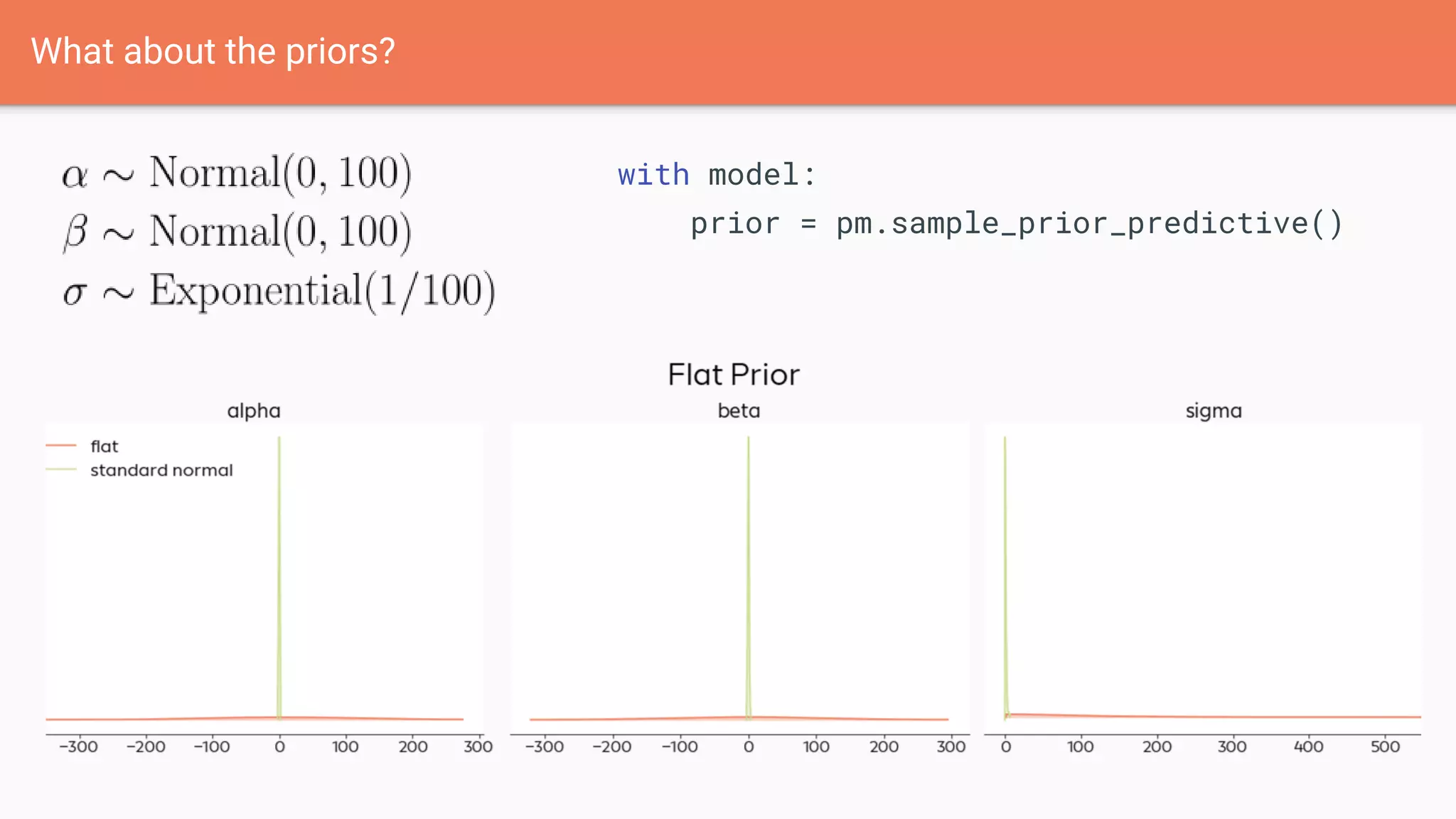The document discusses implementing a hierarchical Bayesian model using PyMC3 and ArviZ for predicting house prices based on factors like area and zip code. It outlines the setup of the model, including the priors, sampling techniques, and checking model convergence. Additionally, it suggests iterating on the model with more predictors and hierarchies for improved accuracy.
















![import pymc3 as pm
with pm.Model() as lin_model:
α = pm.Normal("α", 0, 100)
β = pm.Normal("β", 0, 100)
σ = pm.Exponential("σ", 1/100)
μ = α + β*d["area"]
y = pm.Normal("y", μ, σ,
observed=d["price"])
Getting this into Python: PyMC3](https://image.slidesharecdn.com/bayesianworkflowwithpymc3andarviz-191011122556/75/Bayesian-workflow-with-PyMC3-and-ArviZ-17-2048.jpg)
![import pymc3 as pm
with pm.Model() as lin_model:
α = pm.Normal("α", 0, 100)
β = pm.Normal("β", 0, 100)
σ = pm.Exponential("σ", 1/100)
μ = α + β*d["area"]
y = pm.Normal("y", μ, σ,
observed=d["price"])
Getting this into Python: PyMC3](https://image.slidesharecdn.com/bayesianworkflowwithpymc3andarviz-191011122556/75/Bayesian-workflow-with-PyMC3-and-ArviZ-18-2048.jpg)
![import pymc3 as pm
with pm.Model() as lin_model:
α = pm.Normal("α", 0, 100)
β = pm.Normal("β", 0, 100)
σ = pm.Exponential("σ", 1/100)
μ = α + β*d["area"]
y = pm.Normal("y", μ, σ,
observed=d["price"])
Getting this into Python: PyMC3](https://image.slidesharecdn.com/bayesianworkflowwithpymc3andarviz-191011122556/75/Bayesian-workflow-with-PyMC3-and-ArviZ-19-2048.jpg)
![Getting this into Python: PyMC3
import pymc3 as pm
with pm.Model() as lin_model:
α = pm.Normal("α", 0, 100)
β = pm.Normal("β", 0, 100)
σ = pm.Exponential("σ", 1/100)
μ = α + β*d["area"]
y = pm.Normal("y", μ, σ,
observed=d["price"])](https://image.slidesharecdn.com/bayesianworkflowwithpymc3andarviz-191011122556/75/Bayesian-workflow-with-PyMC3-and-ArviZ-20-2048.jpg)
![with pm.Model() as hier_model:
μ_α = pm.Normal("μ_α", 0, 100)
μ_β = ...
σ = pm.Exponential("σ", 1/100)
σ_α = σ_β = ...
α = pm.Normal("α", μ_α, σ_α,
shape=num_zip)
β = pm.Normal("β", μ_β, σ_β,
shape=num_zip)
μ = α[d["zip"]] + β[d["zip"]]*d["area"]
y = pm.Normal("y", μ, σ,
observed=d["price"])
Getting this into Python: PyMC3](https://image.slidesharecdn.com/bayesianworkflowwithpymc3andarviz-191011122556/75/Bayesian-workflow-with-PyMC3-and-ArviZ-21-2048.jpg)
![with pm.Model() as hier_model:
μ_α = pm.Normal("μ_α", 0, 100)
μ_β = ...
σ = pm.Exponential("σ", 1/100)
σ_α = σ_β = ...
α = pm.Normal("α", μ_α, σ_α,
shape=num_zip)
β = pm.Normal("β", μ_β, σ_β,
shape=num_zip)
μ = α[d["zip"]] + β[d["zip"]]*d["area"]
y = pm.Normal("y", μ, σ,
observed=d["price"])
Getting this into Python: PyMC3](https://image.slidesharecdn.com/bayesianworkflowwithpymc3andarviz-191011122556/75/Bayesian-workflow-with-PyMC3-and-ArviZ-22-2048.jpg)
![with pm.Model() as hier_model:
μ_α = pm.Normal("μ_α", 0, 100)
μ_β = ...
σ = pm.Exponential("σ", 1/100)
σ_α = σ_β = ...
α = pm.Normal("α", μ_α, σ_α,
shape=num_zip)
β = pm.Normal("β", μ_β, σ_β,
shape=num_zip)
μ = α[d["zip"]] + β[d["zip"]]*d["area"]
y = pm.Normal("y", μ, σ,
observed=d["price"])
Getting this into Python: PyMC3](https://image.slidesharecdn.com/bayesianworkflowwithpymc3andarviz-191011122556/75/Bayesian-workflow-with-PyMC3-and-ArviZ-23-2048.jpg)
![with pm.Model() as hier_model:
μ_α = pm.Normal("μ_α", 0, 100)
μ_β = ...
σ = pm.Exponential("σ", 1/100)
σ_α = σ_β = ...
α = pm.Normal("α", μ_α, σ_α,
shape=num_zip)
β = pm.Normal("β", μ_β, σ_β,
shape=num_zip)
μ = α[d["zip"]] + β[d["zip"]]*d["area"]
y = pm.Normal("y", μ, σ,
observed=d["price"])
Getting this into Python: PyMC3](https://image.slidesharecdn.com/bayesianworkflowwithpymc3andarviz-191011122556/75/Bayesian-workflow-with-PyMC3-and-ArviZ-24-2048.jpg)











![with pm.Model() as hier_model:
μ_α = pm.Normal("μ_α", 0, 20)
μ_β = pm.Normal("μ_β", 0, 5)
σ = pm.Exponential("σ", 1/5)
σ_α = σ_β = ...
α = pm.Normal("α", μ_α, σ_α,
shape=num_zip)
β = pm.Normal("β", μ_β, σ_β,
shape=num_zip)
μ = α[d["zip"]] + β[d["zip"]]*d["area"]
y = pm.Normal("y", μ, σ,
observed=d["price"])
trace = pm.sample()
What about the priors?](https://image.slidesharecdn.com/bayesianworkflowwithpymc3andarviz-191011122556/75/Bayesian-workflow-with-PyMC3-and-ArviZ-36-2048.jpg)

























